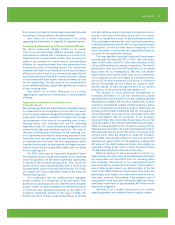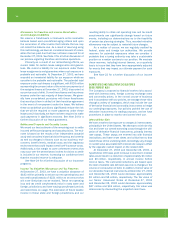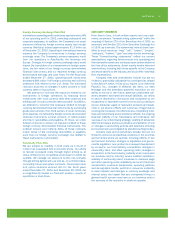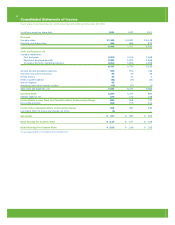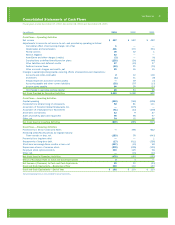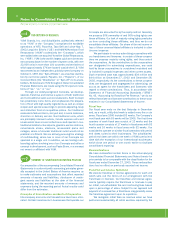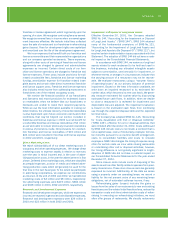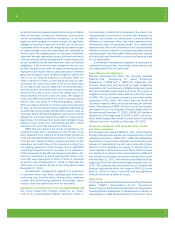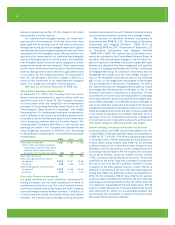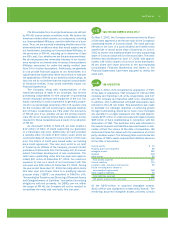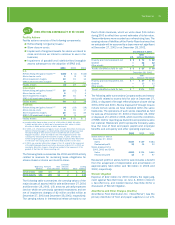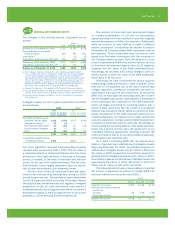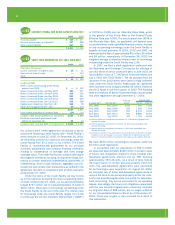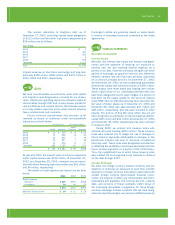Pizza Hut 2003 Annual Report Download - page 56
Download and view the complete annual report
Please find page 56 of the 2003 Pizza Hut annual report below. You can navigate through the pages in the report by either clicking on the pages listed below, or by using the keyword search tool below to find specific information within the annual report.
54.
as held for sale and suspend depreciation and amortization
when (a) we make a decision to refranchise; (b) the stores
can be immediately removed from operations; (c) we have
begun an active program to locate a buyer; (d) significant
changes to the plan of sale are not likely; and (e) the sale
is probable within one year. We recognize estimated losses
on refranchisings when the restaurants are classified as
held for sale. We recognize gains on restaurant refranchis-
ings when the sale transaction closes, the franchisee has a
minimum amount of the purchase price in at-risk equity, and
we are satisfied that the franchisee can meet its financial
obligations. If the criteria for gain recognition are not met,
we defer the gain to the extent we have a remaining financial
exposure in connection with the sales transaction. Deferred
gains are recognized when the gain recognition criteria are
met or as our financial exposure is reduced. When we
make a decision to retain a store previously held for sale,
we revalue the store at the lower of its (a) net book value
at our original sale decision date less normal depreciation
and amortization that would have been recorded during the
period held for sale or (b) its current fair market value. This
value becomes the store’s new cost basis. We charge (or
credit) any difference between the store’s carrying amount
and its new cost basis to refranchising gains (losses).
When we make a decision to close a store previously held
for sale, we reverse any previously recognized refranchising
loss and then record impairment and store closure costs as
described above. Refranchising gains (losses) also include
charges for estimated exposures related to those partial
guarantees of franchisee loan pools and contingent lease
liabilities which arose from refranchising activities. These
exposures are more fully discussed in Note 24.
SFAS 144 also requires the results of operations of a
component entity that is classified as held for sale or has
been disposed of be reported as discontinued operations
in the Consolidated Statements of Income if certain condi-
tions are met. These conditions include elimination of the
operations and cash flows of the component entity from
the ongoing operations of the Company and no significant
continuing involvement by the Company in the operations
of the component entity after the disposal transaction. The
results of operations of stores meeting both these condi-
tions that were disposed of in 2003 or 2002 or classified
as held for sale at December 27, 2003 or December 28,
2002 were not material for any of the three years ended
December 27, 2003.
Considerable management judgment is necessary
to estimate future cash flows, including cash flows from
continuing use, terminal value, closure costs, sublease
income, and refranchising proceeds. Accordingly, actual
results could vary significantly from our estimates.
Impairment of Investments in Unconsolidated Affiliates
We record impairment charges related to an invest-
ment in an unconsolidated affiliate whenever events or
circumstances indicate that a decrease in the value of an
investment has occurred which is other than temporary. In
addition, we evaluate our investments in unconsolidated
affiliates for impairment when they have experienced two
consecutive years of operating losses. Our impairment
measurement test for an investment in an unconsolidated
affiliate is similar to that for our restaurants except that we
use discounted cash flows after interest and taxes instead
of discounted cash flows before interest and taxes as used
for our restaurants.
Considerable management judgment is necessary to
estimate future cash flows. Accordingly, actual results could
vary significantly from our estimates.
Asset Retirement Obligations
Effective December 29, 2002, the Company adopted
SFAS No. 143, “Accounting for Asset Retirement
Obligations” (“SFAS 143”). SFAS 143 addresses the
financial accounting and reporting for legal obligations
associated with the retirement of tangible long-lived assets
and the associated asset retirement costs. As a result of
obligations under certain leases that are within the scope
of SFAS 143, the Company recorded a cumulative effect
adjustment of $2 million ($1 million after tax) which did
not have a material effect on diluted earnings per common
share. The adoption of SFAS 143 also did not have a mate-
rial impact on our Consolidated Financial Statements for
the year ended December 27, 2003. If SFAS 143 had been
adopted as of the beginning of 2002 or 2001, the cumu-
lative effect adjustment would not have been materially
different from that recorded on December 29, 2002.
Financial Instruments with Characteristics of both
Liabilities and Equity
The Company has adopted SFAS No. 150, “Accounting for
Certain Financial Instruments with Characteristics of both
Liabilities and Equity” (“SFAS 150”). SFAS 150 establishes
standards for how an issuer classifies and measures three
classes of freestanding financial instruments with charac-
teristics of both liabilities and equity. It requires that an
issuer classify a financial instrument that is within its scope
as a liability (or an asset in some circumstances). SFAS 150
was effective for financial instruments entered into or modi-
fied after May 31, 2003, and otherwise was effective at the
beginning of the first interim period beginning after June 15,
2003. The Company has not entered into or modified any
financial instruments within the scope of SFAS 150 since
May 31, 2003, nor does it currently hold any significant
financial instruments within its scope.
Guarantees
The Company has adopted Financial Accounting Standards
Board (“FASB”) Interpretation No. 45, “Guarantor’s
Accounting and Disclosure Requirements for Guarantees,
Including Indirect Guarantees of Indebtedness to Others, an
interpretation of FASB Statements No. 5, 57 and 107 and a



